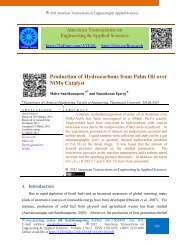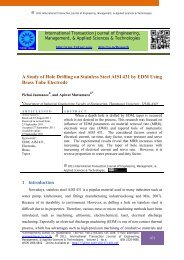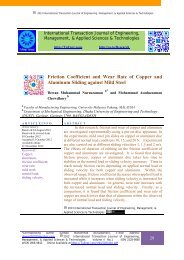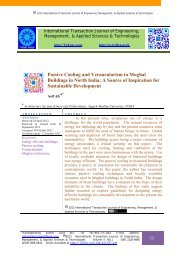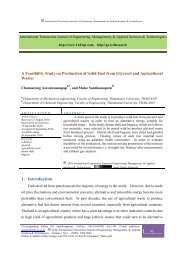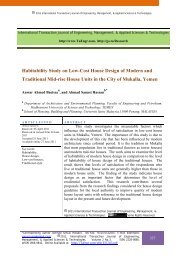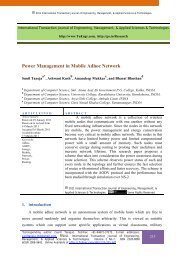Identifying the Sustainable Practices from the Vernacular ...
Identifying the Sustainable Practices from the Vernacular ...
Identifying the Sustainable Practices from the Vernacular ...
Create successful ePaper yourself
Turn your PDF publications into a flip-book with our unique Google optimized e-Paper software.
The aspect of sustainability entails use of natural resources, land, water, and forests. In contextof development, sustainability refers to optimal utilization of resources whereas tribes are usingminimal resources. The land occupied by <strong>the</strong>m for dwelling is limited and keeps on changing<strong>from</strong> place to place, thus posing no harm to landforms. The settlements have single resource ofwater which is a river, waterfall, spring or a community well. There is no provision of sewerage inthose settlements. The waste water is directed into <strong>the</strong> backyard. The waste <strong>from</strong> animals iscollected in <strong>the</strong> outskirts for preparation of organic manure. The nucleus villages, houses people<strong>from</strong> various communities. It includes people <strong>from</strong> various occupations to fulfill <strong>the</strong>ir needs suchas people like carpenter, blacksmith and potter. The festivals are incomplete without <strong>the</strong>involvement of tribal community. The festivity is <strong>the</strong> essence of tribal life. The simple and straightcommunity enjoys festivals with great fervor and joy. Music, painting and artifacts have become asource of income for <strong>the</strong>m. Their knowledge about herbs and o<strong>the</strong>r forest products is helping inconservation of biodiversity.4.2 Typology of HabitatEmpirical study <strong>from</strong> tribal groups of India suggests that <strong>the</strong>re are values, integrating into <strong>the</strong>spatial, social and ritual perspectives and ultimately leading to <strong>the</strong>ir habitat. Their lifestyle isamply represented in <strong>the</strong>ir dwelling which varies depending upon <strong>the</strong> location, occupation,community and <strong>the</strong> micro climate. For analyzing, typologies can be worked out on <strong>the</strong> basis ofspatial configuration, use of materials and building technology & form. However for <strong>the</strong> sake ofsimplicity typology has been worked on <strong>the</strong> basis of spatial configuration. The first type ofdwelling unit shown in Figure 4 is habitat type Model-I, which is <strong>from</strong> <strong>the</strong> nucleus village. This isessentially <strong>the</strong> house of farmer and not <strong>the</strong> house of tribes, who inhibits <strong>the</strong>m. It is <strong>the</strong> richest interms of size, hierarchy of spaces and use of material (see Figure 4). This house has an enclosurefor protection. It has a formal open courtyard used for social activities, semi enclosed private spacewhich is used for guests, a covered living space which is sometimes two storied and cooking spacewith rear courtyard. The enclosure which is semi open is used as animal yard. The tribes engagedas labors are allotted one room or allowed to live in <strong>the</strong> animal yard. The house is elongated along<strong>the</strong> major axis and is geometrically symmetrical. The roof type is lean to for semi open space anddouble lean to for covered and private spaces. The inner private spaces are elevated. The central*Corresponding author (Krishna Kumar Dhote). Tel/Fax: +91-94065 18194/ +91 7552670562. E-mail address: kkdhote@hotmail.com. 2012. American Transactions onEngineering & Applied Sciences. Volume 1 No.3. ISSN 2229-1652 eISSN 2229-1660Online Available at http://TuEngr.com/ATEAS/V01/237-251.pdf243



